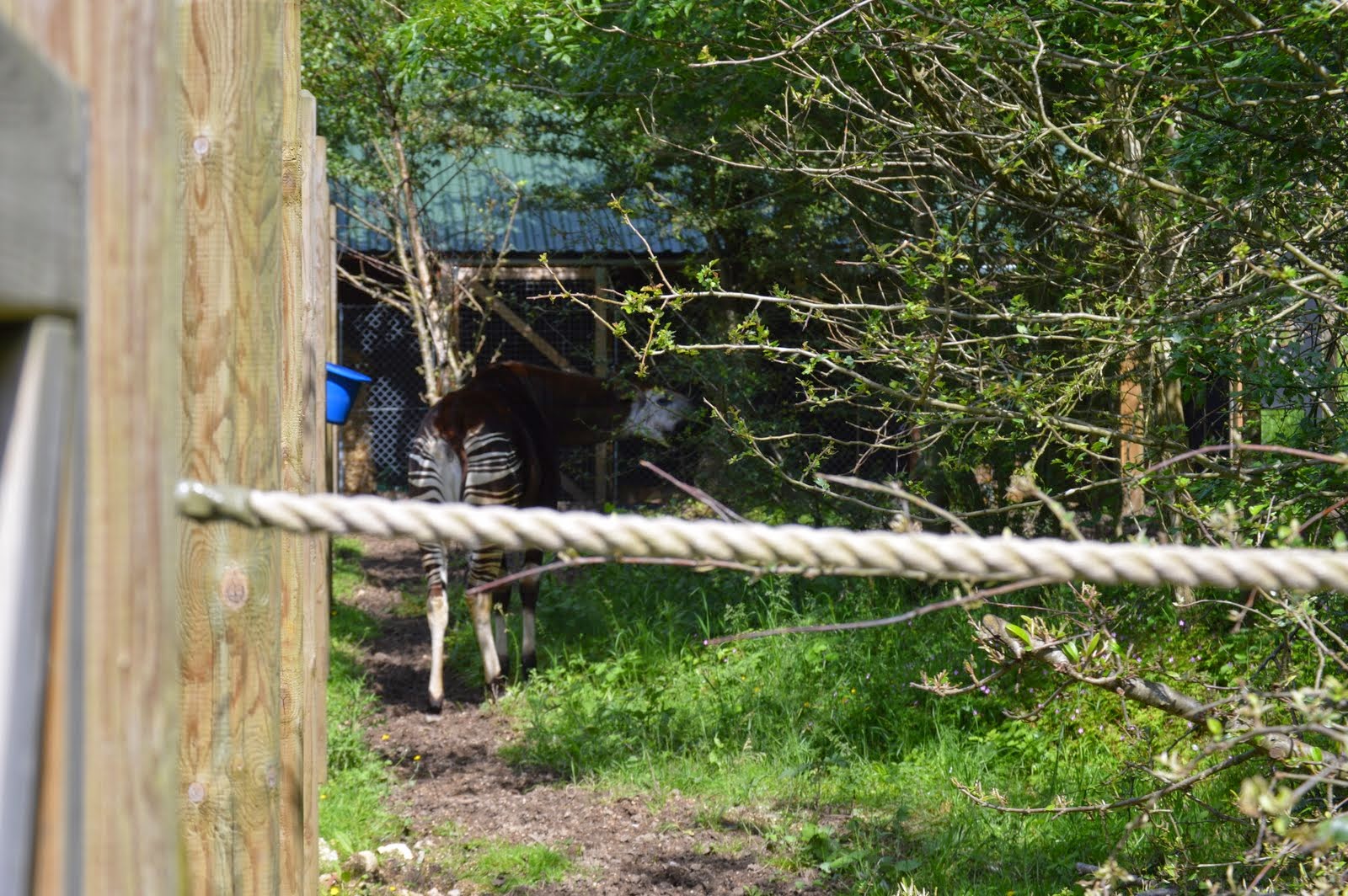 |
| Male Okapi "Rubani", Wildplace |
The most important of the species currently
at Wildplace is the Okapi. When Wildplace opened last year there were two, but
the section is being expanded so that more animals will be held, including one
of the two currently at Bristol and another coming from another zoo.
 |
| Reticulated Giraffe |
 |
| Nigerian Giraffe |
 |
| Masai Giraffe |
When people first see an Okapi, they often
think it is some kind of zebra because of its stripes, but actually it is one
of the few living species of giraffe. The giraffe family is most closely
related to deer of all things, and in the past was much more widespread, with
fossils known from both Europe and Asia – in fact it seems that the giraffe
family first appeared in Europe around 20 million years ago and only later
entered Africa, with the ancestors of the Okapi and the long-necked giraffes
entering the continent separately.. The Okapi is probably the closest in
appearance to the ancestral form, with the long-necked giraffes appearing
later. Incidentally, although everyone talks about “the” giraffe, if you
consider them in detail, long-necked giraffes come in a variety of colour patterns,
number of “horns” (technically called ossicones). Today, it seems more likely
that there several, perhaps as many as six, species of long-necked giraffe,
some of which are now reduced to only a few hundred individuals.
Okapi are not in quite as bad a state as
that, but the population in areas where study is possible (this being the Congo
basin, study of such a rare and secretive animal is anyway very difficult) have
shown serious declines and the total wild population is probably under 10,000,
a 75% decline from a decade ago. Currently it is classed by the IUCN as
Endangered.

 In the wild Okapi are solitary, with large home
ranges. They keep in touch with their neighbors with scent marking, including
marking their trails with scent glands between their toes. The diet comprises
mainly leaves, with some fruits on occasion, grasses, or even fungi. To
compensate for toxins in their diet, wild Okapis eat charcoal from
lightning-struck trees and eat mineral-rich mud. Females are larger than males,
and most of the time are dominant to them which means they get the best food.
Even so, spare resources for growing a baby to term are in short supply, and
Okapi pregnancies are consequently long – just under 15 months.
In the wild Okapi are solitary, with large home
ranges. They keep in touch with their neighbors with scent marking, including
marking their trails with scent glands between their toes. The diet comprises
mainly leaves, with some fruits on occasion, grasses, or even fungi. To
compensate for toxins in their diet, wild Okapis eat charcoal from
lightning-struck trees and eat mineral-rich mud. Females are larger than males,
and most of the time are dominant to them which means they get the best food.
Even so, spare resources for growing a baby to term are in short supply, and
Okapi pregnancies are consequently long – just under 15 months.
Newborn okapis spend a lot of time resting up in thickets. To avoid the smell
of their faeces attracting predators such as leopards, okapi babies have an odd
habit of waiting many days after giving birth before beginning to produce dung
– as long as 41 days has been recorded is usually less.
The calves grow fairly fast, and after are full grown at three years. The
lifespan of an Okapi can be as long as 30 years in captivity, although 15 – 20
is more typical.
Live Okapi were first imported to Europe in 1918, but at
first the stress of capture and transport by ship resulted in high mortality.
Bristol Zoo received the first Okapis in 1961, and was the first zoo in the UK
to breed them. Since then many have been produced, with two from the current
Bristol Zoo female Lodja in the last four years. Lodja will be moving up to
Wildplace once the new enclosures are completed.
One of the problems with captive breeding
programmes is maintaining the genetic integrity of the various source
populations. Before the complexity of the taxonomy of the various (sub)species
of long-necked giraffe was fully realised it was common to mix them, with the
result that many zoos now hold animals which are hybrids and useless for
conservation purposes. Now these hybrids are being progressively removed from
the captive population and separate studbooks are maintained so that
pure-breeding groups of the original forms are maintained. The situation with
Okapi is not so bad, but it does appear that there is considerable genetic
structure in the wild population, as a result of the species being repeatedly
confined to refugia of suitable habitat as the rainforest expanded and shrank
during the Pleistocene. The most important barrier between okapi populations
today is the Congo River, although there seems to be some gene flow across the
river. For more on this, a recent study on PLoS One might be of interest:
·
Distinct and Diverse: Range-Wide Phylogeography Reveals Ancient Lineages
and High Genetic Variation in the Endangered Okapi (Okapia johnstoni) David W.G
Stanton et al Published: July 09, 2014 DOI:
10.1371/journal.pone.0101081
This
brings an end to this series on the animals of Wildplace. Next time, I will
start a new series – subjects to be determined, so watch this space.
(Okapi photos are mine, Giraffe from Wikipedia)


